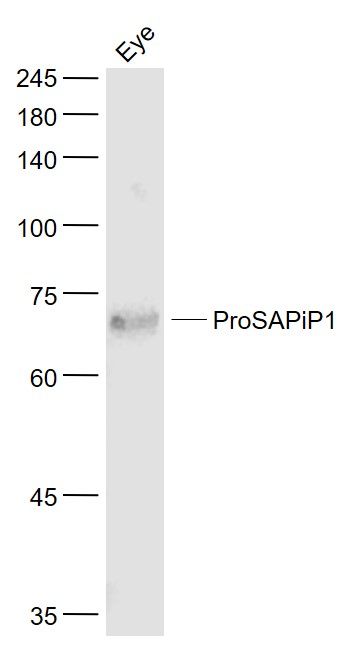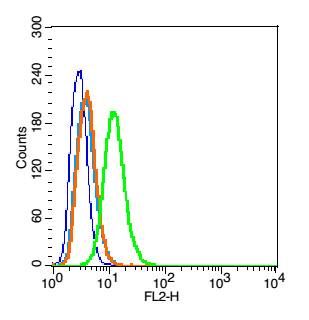ProSAPiP1 Polyclonal Antibody
Purified Rabbit Polyclonal Antibody (Pab)
- 产品详情
- 实验流程
Application
| WB, IHC-P, IHC-F, IF, ICC, E |
|---|---|
| Primary Accession | O60299 |
| Reactivity | Rat, Pig, Dog, Bovine |
| Host | Rabbit |
| Clonality | Polyclonal |
| Calculated MW | 71791 Da |
| Physical State | Liquid |
| Immunogen | KLH conjugated synthetic peptide derived from human ProSAPiP1 |
| Epitope Specificity | 151-250/673 |
| Isotype | IgG |
| Purity | affinity purified by Protein A |
| Buffer | 0.01M TBS (pH7.4) with 1% BSA, 0.02% Proclin300 and 50% Glycerol. |
| SUBCELLULAR LOCATION | Cell junction > synapse > postsynaptic cell membrane > postsynaptic density. Cytoplasm > cytoskeleton. Detected at synapses, postsynaptic density, synaptic spines and dendrites. |
| SIMILARITY | Belongs to the PROSAPIP1 family. |
| SUBUNIT | Interacts (via C-terminus) with SHANK3 (via PDZ domain). Interacts (via coiled coil) with SIPA1L1. Can form homooligomers (By similarity). |
| Important Note | This product as supplied is intended for research use only, not for use in human, therapeutic or diagnostic applications. |
| Background Descriptions | The ProSAP family of proteins contain many protein-protein interaction domains and serve as scaffolding mediators within the post-synaptic density (PSD) of excitatory brain synapses. The PSD is an electron-dense structure underneath the post-synaptic plasma membrane of excitatory synapses that anchors and clusters glutamate receptors opposite to the pre-synaptic neurotransmitter release site. Shank proteins contain PDZ modular domains that coordinate the synaptic localization of ion channels, receptors, signaling enzymes, and cell adhesion molecules. The PDZ domain mediates protein-protein interactions via the recognition of a conserved sequence motif at the C-terminus of their target protein(s). ProSAPiP1 (proline rich synapse associated protein interacting protein 1) is a 673 amino acid protein that interacts with the PDZ domain of Shank 3. ProSAPiP1 expression is brain-specific with highest expression within the cerebellum, hippocampus and cerebral cortex. |
| Gene ID | 9762 |
|---|---|
| Other Names | Leucine zipper putative tumor suppressor 3, ProSAP-interacting protein 1, LZTS3 (HGNC:30139) |
| Dilution | WB=1:500-2000,IHC-P=1:100-500,IHC-F=1:100-500,ICC=1:100-500,IF=1:100-500,Flow-Cyt=1 µg/Test,ELISA=1:5000-10000 |
| Format | 0.01M TBS(pH7.4) with 1% BSA, 0.09% (W/V) sodium azide and 50% Glyce |
| Storage | Store at -20 °C for one year. Avoid repeated freeze/thaw cycles. When reconstituted in sterile pH 7.4 0.01M PBS or diluent of antibody the antibody is stable for at least two weeks at 2-4 °C. |
| Name | LZTS3 (HGNC:30139) |
|---|---|
| Function | May be involved in promoting the maturation of dendritic spines, probably via regulating SIPA1L1 levels at the postsynaptic density of synapses. |
| Cellular Location | Synapse {ECO:0000250|UniProtKB:Q8K1Q4}. Postsynaptic density {ECO:0000250|UniProtKB:Q8K1Q4}. Cell projection, dendritic spine {ECO:0000250|UniProtKB:Q8K1Q4}. Cell projection, dendrite {ECO:0000250|UniProtKB:Q8K1Q4}. Cytoplasm, cytoskeleton {ECO:0000250|UniProtKB:Q8K1Q4}. Note=Rather found at excitatory than inhibitory synapses. {ECO:0000250|UniProtKB:Q8K1Q4} |
Research Areas
For Research Use Only. Not For Use In Diagnostic Procedures.
Application Protocols
Provided below are standard protocols that you may find useful for product applications.
终于等到您。ABCEPTA(百远生物)抗体产品。
点击下方“我要评价 ”按钮提交您的反馈信息,您的反馈和评价是我们最宝贵的财富之一,
我们将在1-3个工作日内处理您的反馈信息。
如有疑问,联系:0512-88856768 tech-china@abcepta.com.























 癌症的基本特征包括细胞增殖、血管生成、迁移、凋亡逃避机制和细胞永生等。找到癌症发生过程中这些通路的关键标记物和对应的抗体用于检测至关重要。
癌症的基本特征包括细胞增殖、血管生成、迁移、凋亡逃避机制和细胞永生等。找到癌症发生过程中这些通路的关键标记物和对应的抗体用于检测至关重要。 为您推荐一个泛素化位点预测神器——泛素化分析工具,可以为您的蛋白的泛素化位点作出预测和评分。
为您推荐一个泛素化位点预测神器——泛素化分析工具,可以为您的蛋白的泛素化位点作出预测和评分。 细胞自噬受体图形绘图工具为你的蛋白的细胞受体结合位点作出预测和评分,识别结合到自噬通路中的蛋白是非常重要的,便于让我们理解自噬在正常生理、病理过程中的作用,如发育、细胞分化、神经退化性疾病、压力条件下、感染和癌症。
细胞自噬受体图形绘图工具为你的蛋白的细胞受体结合位点作出预测和评分,识别结合到自噬通路中的蛋白是非常重要的,便于让我们理解自噬在正常生理、病理过程中的作用,如发育、细胞分化、神经退化性疾病、压力条件下、感染和癌症。







